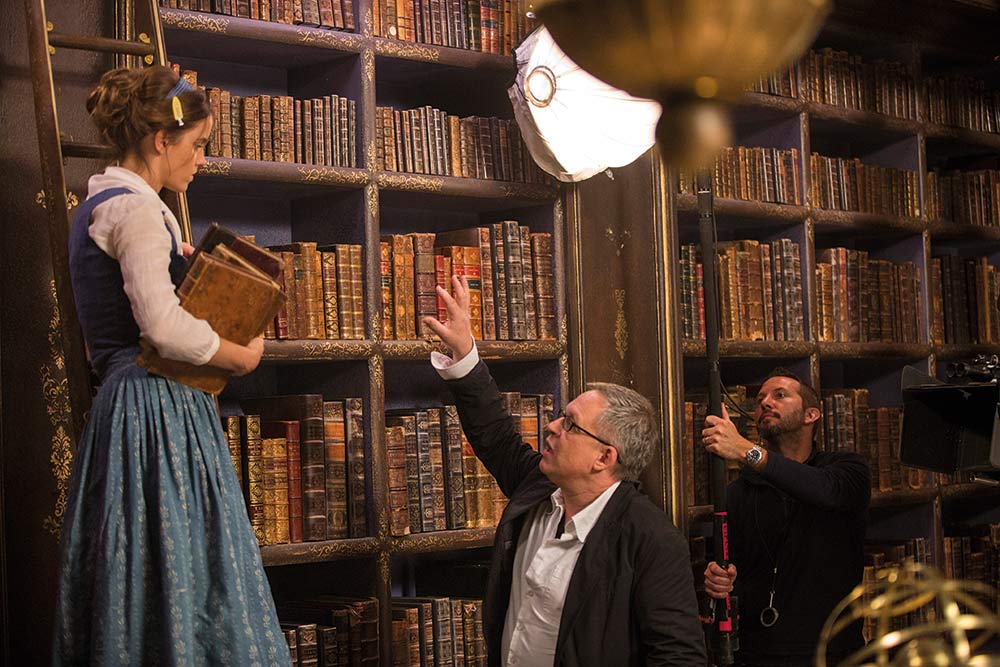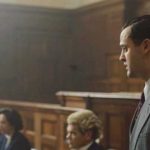
Lighting Disney – Design for Beauty and the Beast
Posted on Aug 31, 2017 by Julian Mitchell
Very high wattage SoftSun lights recreated sunlight flooding in to the castle once Belle started cleaning the windows.
When Disney chose to give its classic animation Beauty and the Beast the live action treatment, those enormous animated sets needed a real-world lighting design
Cinematographer Tobias A Schliessler arrived on the Beauty and the Beast production team
a little later than the production designer Sarah Greenwood. When he started work Bill Condon, the director, had already spent a fair amount of time with Sarah working on illustrations for how the movie would look. Tobias says, “Those illustrations were really our guideline for the look of the movie. There was a huge presentation in terms of costumes, sets and looks and that was presented to Disney and signed off. My job is to come in and look at that and bring it to the screen.
“I was blown away by the illustrations. They were so beautiful that when I saw them I said, ‘I want to make that movie and I want to make it look like that.’ Obviously with a Disney production you can’t go too ‘dark’. If you sign on to a Disney movie you have to live in that world to a certain extent; it is an 18th century French fairy tale and a musical so that brings a certain look automatically to the table. I think we pushed the envelope as far as we could. You have to keep it stylised and cinematic and also for a period piece keep it modern in a sense: with our camera moves for instance.”
Those sets

Beauty and the Beast was a UK-made production on huge sets in Shepperton. Tobias is very complimentary about the skill levels of the crew. “Everything was on sets, we even built the chase scene in the forest with horse and wagons and wolves chasing,” he says. “That was all an enormous set. It took us close to two months just to rig the lights in that set because it was so enormous. We always had six or seven stages going at the same time. We had one stage that was two combined so we were able to build the castle entrance on there, and the castle ballroom which is almost two storeys high. I’ve never seen bigger sets in my life, and they were all so beautifully designed and crafted. The craftsmanship in the UK is something I’ve never experienced before; everything was made from scratch, nothing came off a shelf or from a props department.”
Lighting Design
How do you start planning your light rigs on such a huge production? “It starts from models that we get from the art department,” says Tobias. “Then I would sit with my chief gaffer with the illustrations and the models with a plan. So we would say, ‘this is the kind of look that we want.’ Then you start picking what you need; here’s my ambient, here are the softboxes over the top, here are the key lights. I actually thought about going to incandescent tungsten light that was warmer and would flicker a little more. But during preparation the new LEDs started to come out.”
“The craftsmanship in the uk is something i’ve never experienced before; everything was made from scratch ”
Tobias had always had problems with LEDs, with their colour temperature and certain colour spikes in them that he didn’t like. But the Kino Flos and ARRI Skypanels persuaded him to swap 70% of his lights to LEDs. Everything was controlled from a big dimmer board that ended up being on an iPad in his DIT area. Everything was automated and DMX controlled.
 Massive sets in Shepperton were enhanced by 700 Kinoflos.
Massive sets in Shepperton were enhanced by 700 Kinoflos.
“It takes weeks of planning where the lights will go, then it obviously take a long time just to rig the cabling of these sets,” he explains. “In the set where we had the forest I had 700 Kino Flos up in the ceiling and then I had over a million watts of SoftSuns hanging which created either sun or moonlight wherever I wanted it. I had an amazing crew with 70 or 80 people working for me on any given day pre-rigging on different sets. They also built the exterior of the French village; that was built in the backlot with a lot of control.
“Usually with these sets they are building to the last possible moment but I like to give myself three or four days so I can come in and do some pre-lighting and get prepared. But this time we were battling with the art department as they finished the sets so we only got a couple of hours here and there. The sets ideally are all rigged around five days before we start shooting. We would shoot around the first eight weeks on most of our sets and then move outside for two or three weeks while they started turning sets around again. We’d usually go in to stages twice for two different sets. Some of the sets you can leave the lights but often it’s a completely new relight and resetting that’s needed.”
Musical numbers
The big musical numbers required different lighting according to the mood of each scene. “The last musical dance number in the ballroom, where the Beast turns back into the Prince, wanted to be full of sunlight so I had lights coming in through the windows to give that warm feeling,” explains Tobias. “The first big musical number, when the Prince actually turns into the Beast, was more dramatic. It started out as a night ballroom scene with around 50 dancers and 50 different shades of white ballgowns. That was lit by candlelight. But when the enchantress brings in the rose the doors open, the wind blows out the candles and we are thrown into darkness with lighting effects. That is lit by moonlight with just a few candles left. So we had to do a lighting shift: from big chandeliers, to a few candles left, to moonlight coming in with lightning. So there alone in one scene are three different looks.
“For the night scenes inside the castle I used
very soft LED boxes for the moonlight”
“That was the beautiful thing about the LEDs,” he continues. “For example, I had these big softboxes made that had the feeling of a chandelier top light. So when the chandeliers get blown out, I could change the feeling from a warm feeling, to a very cool look two stops under. That was really hard to do without LEDs; now I can just shift the temperature to any colour I want.
 The ballroom lighting was a mixture of candles and softboxes.
The ballroom lighting was a mixture of candles and softboxes.
“Another scene is in the ballroom where Belle cleans a window and the sunlight comes through. First we have a cool feel inside the ballroom but when the first rays of sunlight come in I changed the colour temperature of the boxes from a cool to a very warm look and brought the whole room up by about a stop. The new technology really gave me a lot of freedom; we could light very theatrically in a sense.”
Be My Guest sequence
This is the biggest musical number of the film: so big in fact that the director went elsewhere for the lighting design. Famous Broadway and movie lighting designers Jules Fisher and Peggy Eisenhauer were brought in to design this set piece. They had already worked with the director for Chicago and Tobias had worked with them on Dreamgirls with Bill Condon the director. “They designed the lighting just for that number,” says Tobias. “Jules Fisher is like the number one lighting designer on Broadway. They designed that number because it was so specific to Broadway musicals. It referenced a lot of different famous numbers; they’re so knowledgeable about Broadway lighting, and as a cinematographer you really don’t have that technology and technique.
“Their style is all automated lighting, particularly linked to the music,” he explains. “It’s synchronised to a fraction of a beat. In a sense this is the smallest number in terms of size and room; it’s in the dining room of the castle and so not the biggest space. But it’s the number of lighting changes which is the enormous thing.
 70% of the lighting design was changed to LEDs.
70% of the lighting design was changed to LEDs.
“For the night scenes inside the castle I used very soft LED boxes for the moonlight and I had the light coming through the window,” continues Tobias. “Moonlight is one of the hardest things to do in movies, I find, especially when you have movies where that’s your only source. A lot of times we definitely tried to sneak in a candle; like when they were driving at night in the carriages I had candles on the side. You have to find some kind of warm source to partner the moonlight. I used these big SoftSuns because they create a very wide spread with a very clean shadow – I don’t want to see double or triple shadows.”
The only scene in the movie shot on location was the scene where they enter the frozen forest. “There we shot in a real forest,” says Tobias, “and the trees were so dense that it was really hard to light with one source. It’s my worse thing to do; you put up one light and you can’t get the light through the trees. On stage we have control and use these big SoftSuns. Of course using the colour temperature within the ARRI Alexa I could then use the same lights for sunlight, I would just bring the density up brighter on the dimmers and change the temperature on the camera. For a set the size of a football pitch we can change from night to day within an hour.
“The new Leica Summilux-C lenses gave me about f/1.4 wide open. A lot of the time lenses at f/1.4 fall apart but these were beautiful wide open and allowed me to really use the candlelight as light sources. I tested three or four different lenses from the Panavision to Cooke lenses and the Leicas were definitely the ones that were holding up the nicest. They just had richer blacks than anything else and also the way they flared was great. A candle is a very bright source and can flare-out the lenses so it’s not so good looking but the Leicas were great at this.”








